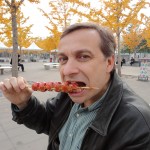
Candied hawthorns at Olympic Park, Beijing
I call this site Science Traveler. And I’m currently out science traveling. So, what is science traveling? I’m glad you asked. Though the answer isn’t as clear cut as it might seem.
I’ve been a scientist for many years, and as a result have done a little bit of travel. Emphasis on “little” and “bit.” Besides the many wonderful days spent in luxurious locales such as oil refineries, sewage treatment plants, and mud bogs, I regularly attended scientific conferences in cities around the United States and Canada. A delightfully drenched week in Vancouver spent entirely inside a convention center epitomizes the excitement of that annual opportunity. For the last 15 years, however, travel has became a lot more interesting.
I’ve been lucky enough to live overseas on three different occasions, in St. George’s, Bermuda; Edinburgh, Scotland; and most recently, Brussels, Belgium. I’ve been to Asia several times, tootled around a good part of Europe, and currently am trekking through a couple of countries south of the equator. Now that I’m writing books and freelancing full time, my travels will become more frequent and more adventurous. They will also become story lines. And those story lines will usually contain some science angle.
Science traveler. Like asking whether Galileo actually did drop balls from the Leaning Tower of Pisa, and if he did, was someone at the bottom to catch them? Like, how is it that I could carry on a conversation with an elderly (and slightly inebriated) Japanese gentleman when neither one of us spoke the others language? Like, how many Argentinian students does it take to get a visiting scientist to wade into a stream alongside an electroshock fisherman?
Of course, science traveling can also mean simply appreciating the ephemeral beauty of a sinking sunset over a Mexican beach, the astonishing talent of a renaissance artist in the Vatican, or the portentous river of water sluicing down a melting glacier in Chile. It might also include crawling through caves in Tennessee after overlooking one of the Civil War’s most infamous battle sites, admiring the orchids of Tenerife, or visiting the latest in a long list of aquariums.
Science traveling most definitely includes photographs. Thousands of photographs. And with each photo comes a story…or many stories. Science traveler will tell those stories.
So while I’m out science traveling I’ll post some photos, some stories, and hopefully some scientific insights that will bring the world closer to everyone.
David J. Kent is an avid traveler and the author of Tesla: The Wizard of Electricity. You can order a signed copy directly from me, download the ebook at barnesandnoble.com, and find hard copies exclusively at Barnes and Noble bookstores.
Follow me by subscribing by email on the home page. And feel free to “Like” my Facebook author’s page and connect on LinkedIn. Share with your friends using the buttons below.











Looking forward to the science traveling stories!!
Me too! 🙂
Photos, photos!
Absolutely. I have three cameras (including the phone) and just loaded up on new memory sticks. 🙂